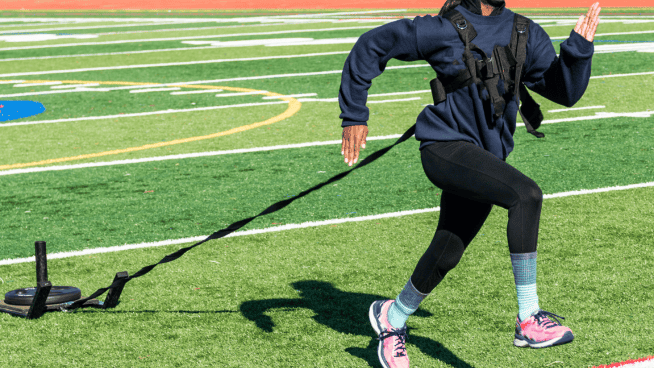Change How You Work Out at Home to Impact Your Training Intensity
It seems home workouts have been going on since the beginning of time. Before there were elliptical machines, kettlebells and other “tools of fitness,” there were old-school bodyweight exercises. Once dubbed calisthenics, they were used to condition the human body before we created useful tools to train more efficiently and productively.
But just because we have moved to more technical ways of training ourselves physically with training tools, doesn’t mean that training with body weight only is a lost cause or outdated. A better argument is this: Can we create a way to train with bodyweight exercises where HOW you perform the exercises are just as important as which exercises you select to perform? The answer is YES.

Combine a traditional Push-Up with other exercises to create a more intense training session using only bodyweight exercises.
Let’s face it: a Push-Up is a Push-Up. Sure you can add a clap at the top, or elevate your feet, but it’s still a Push-Up. But if you take that Push-Up and combine it with other exercises and create a training session by emphasizing HOW the training session is done, then you have a game changer on an intensity level.
The Exercises
For our sample, lets a look at six bodyweight exercises and the number of reps you’d do for each set:
- Push-Ups (10 reps per set)
- Air Squats (25 reps per set)
- Burpees (15 reps per set)
- Sit-Ups (25 reps per set
- Single-Leg RDL’s (10 reps per leg per set)
- Reverse lunges (10 reps per leg per set)
Done individually, one exercise and one set at a time you would have the “conventional format,” execute it and be done.
Here are three ways to do the above same exercises with an emphasis on how you do the workout that changes the intensity.
Options A: The Rundown Format
To add intensity, perform a set of the first exercise, recover 30-45 seconds and perform a set of the next exercise, recover, and so on until you complete the final exercise. Thats one set. Rest 2 minutes then repeat the same cycle three more times.
Option B: The Intermission Format
Choose one of the exercises as your “intermission” exercise. This is an exercise that you do for one set between each exercise. For example, choose Burpees as your Intermission exercise. Perform 4 sets of 10 Push-Ups with about 45 seconds between each set. When four sets are complete, fire through a set of 15 Burpees. After Burpees are complete, perform 4 sets of 25 Air Squats with 45 seconds between each set. When four sets are complete, fire through a set of 15 Burpees.
Complete this cycle until you have completed all of the exercises with a “Burpee Intermission” between each one (remember, any exercise can be chosen for the intermission!)
Option C: The Super Set – Intermission
This is a combination of both formats above while adding super setting to the equation. Of the six exercises, superset them together to create 3 groups. For this example you would super set:
- Push-Ups + Air Squats
- Burpees + Sit-Ups
- Single-Leg RDL’s + Reverse Lunges
Perform 10 Push-ups and immediately stand and perform 25 Air Squats. Recover for 45 seconds and repeat the superset of Push-Ups and Air Squats three more times.
After this is done choose an exercise to do that is NOT in your super set and perform as the “Intermission” for 60 seconds (you could choose Jumping Jacks, Tuck Jumps, Mountain Climbers, etc). For this example, we will perform Mountain Climbers for the 60 second intermission.
Once the Mountain Climber Intermission is complete, move on to the super set of Burpees and Sit-Ups, performing them in the same manner as the back to back Push-Ups and Air Squats. Once 4 sets are complete, perform the 60-second intermission Mountain Climber and move on to the final super set of RDL’and Lunges.
From the three approaches you can see how we have taken six exercises that require no training tools—only body weight—and created different training formats. The intensity is varied according to HOW each training session was performed in terms of the recovery time, format, order and paring of exercises.
This was done without using a single training tool!
Daimond Dixon – Daimond Dixon has trained athletes for the past 20+ years, working with athletes from sports such as football, soccer, hockey, baseball, basketball, lacrosse, rugby, softball, swimming, golf and MMA. He currently serves as the Director of Sports Performance for Grand Rapids (MI) Christian Schools.
Photo Credit: Stígur Már Karlsson /Heimsmyndir/iStock
READ MORE:
RECOMMENDED FOR YOU
MOST POPULAR
Change How You Work Out at Home to Impact Your Training Intensity
It seems home workouts have been going on since the beginning of time. Before there were elliptical machines, kettlebells and other “tools of fitness,” there were old-school bodyweight exercises. Once dubbed calisthenics, they were used to condition the human body before we created useful tools to train more efficiently and productively.
But just because we have moved to more technical ways of training ourselves physically with training tools, doesn’t mean that training with body weight only is a lost cause or outdated. A better argument is this: Can we create a way to train with bodyweight exercises where HOW you perform the exercises are just as important as which exercises you select to perform? The answer is YES.

Combine a traditional Push-Up with other exercises to create a more intense training session using only bodyweight exercises.
Let’s face it: a Push-Up is a Push-Up. Sure you can add a clap at the top, or elevate your feet, but it’s still a Push-Up. But if you take that Push-Up and combine it with other exercises and create a training session by emphasizing HOW the training session is done, then you have a game changer on an intensity level.
The Exercises
For our sample, lets a look at six bodyweight exercises and the number of reps you’d do for each set:
- Push-Ups (10 reps per set)
- Air Squats (25 reps per set)
- Burpees (15 reps per set)
- Sit-Ups (25 reps per set
- Single-Leg RDL’s (10 reps per leg per set)
- Reverse lunges (10 reps per leg per set)
Done individually, one exercise and one set at a time you would have the “conventional format,” execute it and be done.
Here are three ways to do the above same exercises with an emphasis on how you do the workout that changes the intensity.
Options A: The Rundown Format
To add intensity, perform a set of the first exercise, recover 30-45 seconds and perform a set of the next exercise, recover, and so on until you complete the final exercise. Thats one set. Rest 2 minutes then repeat the same cycle three more times.
Option B: The Intermission Format
Choose one of the exercises as your “intermission” exercise. This is an exercise that you do for one set between each exercise. For example, choose Burpees as your Intermission exercise. Perform 4 sets of 10 Push-Ups with about 45 seconds between each set. When four sets are complete, fire through a set of 15 Burpees. After Burpees are complete, perform 4 sets of 25 Air Squats with 45 seconds between each set. When four sets are complete, fire through a set of 15 Burpees.
Complete this cycle until you have completed all of the exercises with a “Burpee Intermission” between each one (remember, any exercise can be chosen for the intermission!)
Option C: The Super Set – Intermission
This is a combination of both formats above while adding super setting to the equation. Of the six exercises, superset them together to create 3 groups. For this example you would super set:
- Push-Ups + Air Squats
- Burpees + Sit-Ups
- Single-Leg RDL’s + Reverse Lunges
Perform 10 Push-ups and immediately stand and perform 25 Air Squats. Recover for 45 seconds and repeat the superset of Push-Ups and Air Squats three more times.
After this is done choose an exercise to do that is NOT in your super set and perform as the “Intermission” for 60 seconds (you could choose Jumping Jacks, Tuck Jumps, Mountain Climbers, etc). For this example, we will perform Mountain Climbers for the 60 second intermission.
Once the Mountain Climber Intermission is complete, move on to the super set of Burpees and Sit-Ups, performing them in the same manner as the back to back Push-Ups and Air Squats. Once 4 sets are complete, perform the 60-second intermission Mountain Climber and move on to the final super set of RDL’and Lunges.
From the three approaches you can see how we have taken six exercises that require no training tools—only body weight—and created different training formats. The intensity is varied according to HOW each training session was performed in terms of the recovery time, format, order and paring of exercises.
This was done without using a single training tool!
Daimond Dixon – Daimond Dixon has trained athletes for the past 20+ years, working with athletes from sports such as football, soccer, hockey, baseball, basketball, lacrosse, rugby, softball, swimming, golf and MMA. He currently serves as the Director of Sports Performance for Grand Rapids (MI) Christian Schools.
Photo Credit: Stígur Már Karlsson /Heimsmyndir/iStock
READ MORE:










